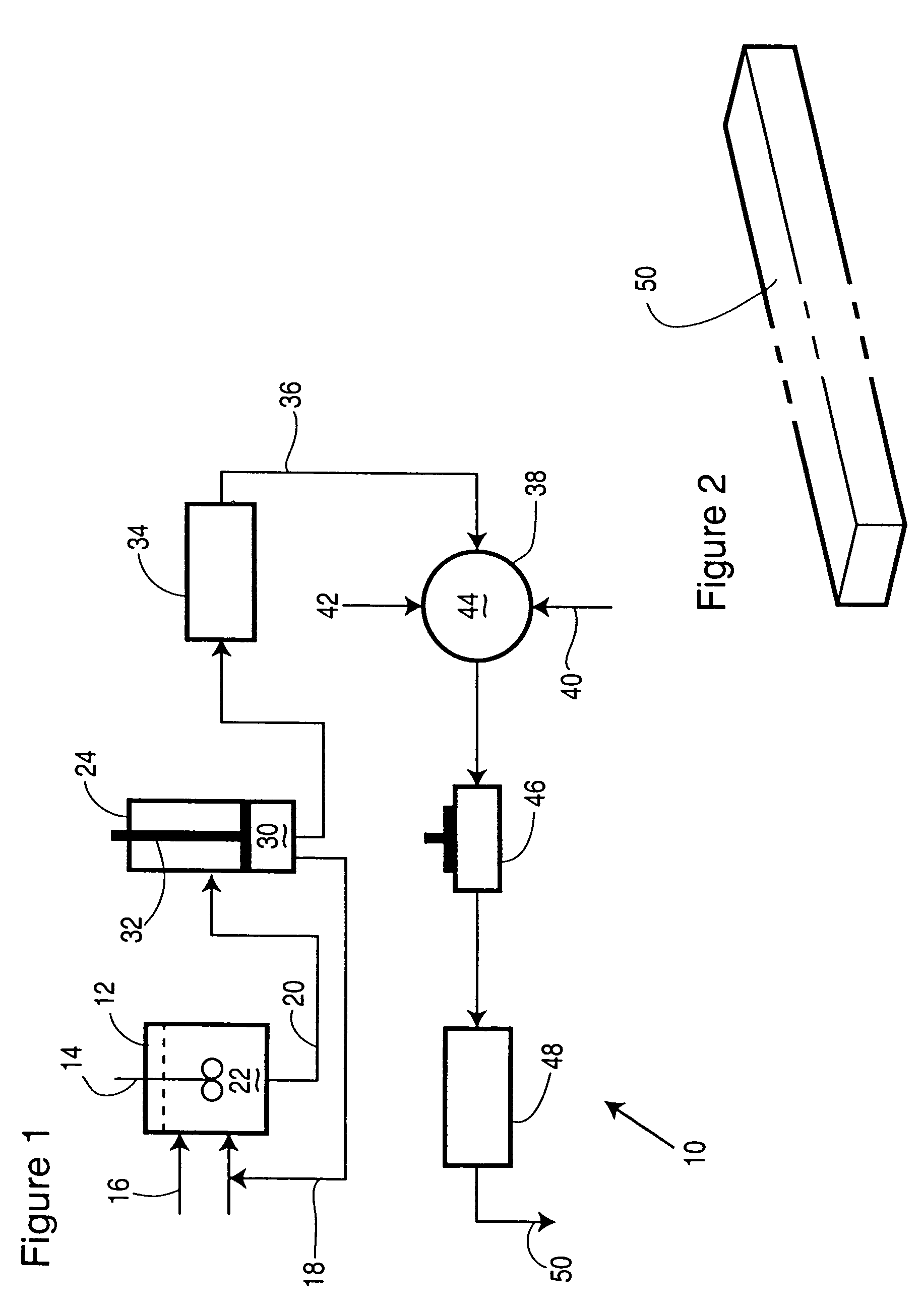Lignocellulose fiber-resin composite material
a technology of lignocellulose fiber and resin, which is applied in the field of lignocellulose fiberresin composite materials, can solve the problems of slow and difficult roll installation and removal, excessive weight and high erection cost, and achieve the effects of improving skin formation, reducing production costs, and improving process efficiency
- Summary
- Abstract
- Description
- Claims
- Application Information
AI Technical Summary
Benefits of technology
Problems solved by technology
Method used
Image
Examples
example 1
[0052]As a starting material, 140 grams of bleached paper grade sulfite pulp was mixed with 50° C. water in a British Disintegrator to produce a slurry with a consistency of 2.5%. The slurry was then poured into a perforated formation trough and the trough topped up with water. Without external pressure, there is only minimal water loss. The slurry in the trough was mixed again to ensure good randomization. The plunger was set in place and forced downward by hand to begin the dewatering step. Once the end of the plunger shaft had descended enough, the slurry was compressed under a screw mechanism to attain a dry bulk density of 0.45 g / cm3. The bottom plate was removed and the wet fiber form in the shape of a rectangular brick of length 20 cm, width 10 cm and thickness 5 cm, was pushed out the bottom and placed in an oven at 85° C. for 8 hours to dry.
[0053]The dry brick was cut into 6 pieces, four of them were labeled 3A, 3B, 3C, 3D and their weights measured. One at a time, each pie...
example 2
[0060]Using the same preparation as in Example 1, two fiber bricks of differing densities (series 2 fiber density: 0.53 m / cm3, series 1 fiber density: 0.46 g / cm3) were produced, segmented, impregnated with resin TXIM 383 and the impregnated pieces cured. The difference with these sets was that higher pressures were attempted. Table 2 lists the results.
[0061]
TABLE 2Final BonePressureTimeInitial Air DryDry CompositeSample ID(psi)(min)Pulp Wt (g)Wt (g)Visual Inspection2C90-1002.520.745.2Slight non-impregnatedcore2A90-1005.022.649.0Fully impregnated2B1107.520.451.5Fully impregnated2D90-10010.023.849.3Fully impregnated1A1000.522.943.3Large non-impregnatedcore1B1001.021.248.1Slight non-impregnatedcore1C1001.519.650.8Fully impregnated1D1002.021.951.1Fully impregnated
[0062]A summary of the observations is as follows:
[0063]During impregnation, there appeared to be minimal fiber swelling.
[0064]All of series 2 were almost completely impregnated. This indicates that less impregnation time is re...
example 3
[0066]Using the same preparation as in Example 1, three other phenol formaldehyde resin formulations were tested in order to observe any differences during impregnation and curing. Samples from all three previous fiber shape series were used under two impregnation pressure and time conditions. The resin viscosities are listed below along with the impregnation temperature. Table 3 describes the results.
[0067]TDIM 387: viscosity 252 cps@ 25C
[0068]TXIM 389: viscosity 148 cps @ 25C
[0069]TXIM 391: viscosity 272 cps @ 25C
[0070]Impregnation temp: 21C.
[0071]
TABLE 3InitialFinalWeightSamplePressureTimeAD PulpBD wtIncreaseResin CodeID(psi)(min)Weight (g)(g)(%)TXIM 3871E15419.729.433TXIM 3892E15420.332.058TXIM 3913E15421.432.050TXIM 3871F30224.135.949TXIM 3892F30224.741.668TXIM 3913F30225.638.651
[0072]The results are as follows:
[0073]The lower viscosity TXIM 389 impregnated much faster, but the percentage of lower molecular weight material seems to be higher (i.e. larger brown region). This may...
PUM
| Property | Measurement | Unit |
|---|---|---|
| thickness | aaaaa | aaaaa |
| length | aaaaa | aaaaa |
| length | aaaaa | aaaaa |
Abstract
Description
Claims
Application Information
 Login to View More
Login to View More - R&D
- Intellectual Property
- Life Sciences
- Materials
- Tech Scout
- Unparalleled Data Quality
- Higher Quality Content
- 60% Fewer Hallucinations
Browse by: Latest US Patents, China's latest patents, Technical Efficacy Thesaurus, Application Domain, Technology Topic, Popular Technical Reports.
© 2025 PatSnap. All rights reserved.Legal|Privacy policy|Modern Slavery Act Transparency Statement|Sitemap|About US| Contact US: help@patsnap.com

